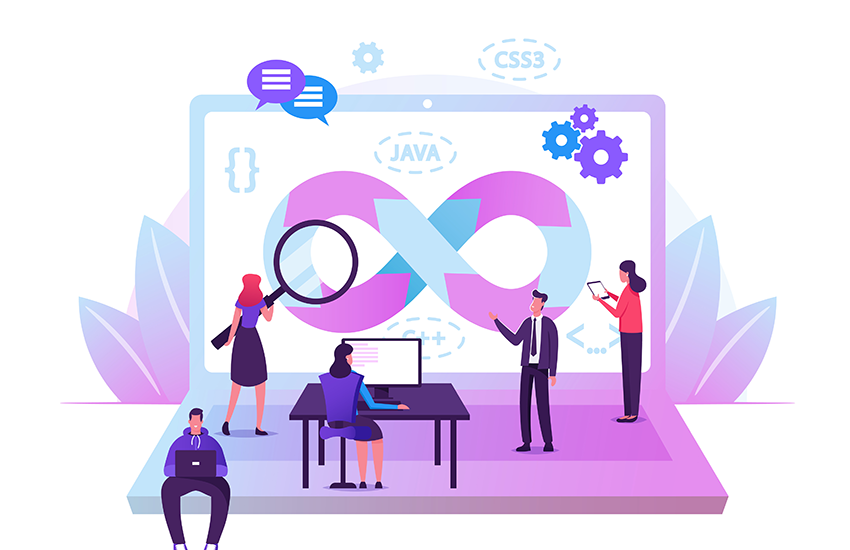New-age businesses strive to be agile and adapt newer technologies and processes to keep up with the evolving market trends. Success in running an enterprise substantially depends upon the success or failure of this digital transformation. For years, businesses have employed traditional SDLC (software development lifecycle) with typical processes and business mindset.
But in today’s era, businesses have no other option than to increase their agility. New-age businesses must embrace CI/CD, automation, and agile paradigms to gain a competitive edge. The typical pre-DevOps era had significant issues such as lack of frequent interdepartmental collaboration, delay in product releases, lack of testing, and longer time required to fix the post-release problems.
DevOps aims to bridge this interdepartmental gap with its open collaborative culture! All the departments are responsible for the SDLC, which ultimately leads to closer collaboration, a customer-centric approach, and a better work environment.
CI/CD and agile mindset are integral parts of DevOps culture, ensuring you always have a deployment build ready. With seamless collaboration, any software change will be automatically synced, tested, and deployed to the production environment. This approach allows for frequent product releases to cater to market demands.
In this article, we elucidate the first steps you need to take for a successful DevOps Transformation. Let's begin.
Common Challenges in DevOps Transformation
Adopting DevOps culture has its ups and downs, as businesses are bound to face some bottlenecks in this journey. Simply migrating to the cloud or adding a CI pipeline isn’t enough. DevOps Transformation calls for identifying pain points, risk mitigation, agile mindset, and building a team of DevOps software developers and engineers to lay a strong foundation.
Here are some of the common challenges you might face during DevOps Transformation:
- Inability to communicate DevOps roadmap to stakeholders: Businesses may build a visually immersive, innovative DevOps roadmap, but it may still fail if teams don’t understand their role in the release process. Close ties and frequent communication are the keys to keeping all stakeholders on the same page. Everyone onboard must know their role along with clear DevOps’ strategic goals and vision.
- Devising inflexible, long-term DevOps plans: Instead of creating a long-term, rigid DevOps plan, create an agile DevOps roadmap that will go through regular upgrades, discussion, and collaboration as per the need for alterations. Rigid deadlines and a lack of flexibility to make changes may eventually lead to failure.
- Lack of clarity and inability to prioritize goals: Teams often find themselves trying to accomplish multiple DevOps initiatives simultaneously. This happens when your DevOps plan lacks the prioritization of goals. The key to DevOps success is to create a prioritization framework while keeping the overall organizational context in mind.
- Difficulty in deriving the right metrics for DevOps: Identifying and focusing on the right metrics is something organizations struggle with, even today. DevOps workflows must be metrics-driven to ensure the team is headed in the right direction. Keeping track of the right metrics will help you measure goals, attain high-level strategies and take appropriate actions.
Roadmap to Successful DevOps Transformation
DevOps success needs a strategic approach. Organizations need to create a systematic, step-by-step transformation plan to adopt DevOps, instead of replacing legacy systems with everything new, all at once.
Here are the key steps to start your DevOps transformation, which include optimal roadmap, tool selection, strategy implementation, automation, piloting, and continuous learning opportunities.
1. Strategic DevOps Planning
Initial planning is customized as per the specific needs of each organization. To be DevOps-ready, you need to consider various factors such as DevOps practitioners, inputs, design approach, existing collateral, etc. Which will reap high-level outputs. Participant teams need to include all components that accelerate delivery. This goes hand-in-hand with security, development, and operations. The goal is to get executive buy-ins and understand what an agile DevOps program is all about.
Most enterprises already have small immature DevOps programs in silos. You can scale these DevOps programs across enterprises with the expertise of all stakeholders.
2. Setting Up DCoE (DevOps Center of Excellence)
The first step to setting up DCoE is appointing an Executive DevOps Leader that will bring in support and buy-ins from all participant departments. Active participants in the Center of Excellence (CoE) will be vendor organizations and representatives from various delivery departments, chosen wisely. The setup of DCoE will lay a solid foundation to build vision, strategies, and best practices for DevOps. It is a shared platform where all participants will share their DevOps experiences and learn from inputs.
3. Create an Open Culture of Collaboration and Learning Across Enterprise
DevOps aims to change employee mindset, business processes, and working culture altogether. Hence, DevOps ought to get resistance from employees, thereby forming bottlenecks in the transformation journey. To fix this, you need to create an open culture of collaboration and inclusion to boost team spirit and morale.
Agile DevOps transformation is possible when each participant is willing to learn, foster, and implement their roles and responsibilities in a collaborative environment.
4. Establish DevOps KPIs
DevOps SMEs (Subject Matter Experts) must conduct workshops and communications plans where they’ll frequently convey program objectives, successes, and milestones. Project intake will help you measure the success of each DevOps practice adopted.
Right-sizing of tools and processes is the key to employing and accelerating development methods. Once tool selection is established, there needs to be frequent collaboration across the enterprise regarding the intake process. Collect feedback and continuously strategize to mature. Establish program KPIs to switch from individual metrics to a greater picture of holistic customer outcomes.
5. Run Pilot Programs and Compare Test Results With KPIs
At this step, DevOps participants pinpoint the right domains and applications to employ DevOps practices. This portfolio must be able to scale up to the enterprise level.
DevOps pilot projects will help teams and stakeholders test their newly implemented tools and processes through a small project. Choose a small pilot project and ensure all components to run the end-to-end process are in places such as guidelines, toolchains, participants, and automated testing processes. Run pilot projects and compare outcomes with KPIs to measure DevOps success.
6. Scale to Improve DevOps
The final step is to gather feedback from KPIs of the pilot programs and mature them. Run multiple release trains from numerous application containers. Automated deployments and regular builds are not enough. Continuous optimization, continuous feedback, and scaling are just as important.
How DevContentOps Extends DevOps Transformation?
DevOps is an open culture of collaboration between development and operations teams to accelerate SDLC and accomplish continuous delivery. DevContentOps enhances this by introducing content management, content operations, and the CMS into the DevOps process and CI/CD tooling.
Today, content is king, and it has entered every organizational department via a variety of content-rich digital experiences. DevOps alone cannot build content-centric, visually-immersive digital experiences for end-users. DevOps practices generally do not take content teams, content tools, and related processes into consideration. To resolve this, DevContentOps leverages a new cultural mindset where applications are built with the seamless collaboration of content authors, IT Ops, and developer teams. This not only creates extraordinary next-gen digital experiences for the audience but also boosts business growth.
Right from connecting with the audience to scaling and communicating with internal teams, DevContentOps offers newer content tools and processes to execute optimal content management, content ops and content publishing workflows.

 Hitesh Jethva
Hitesh Jethva




